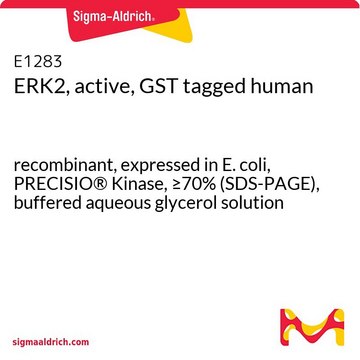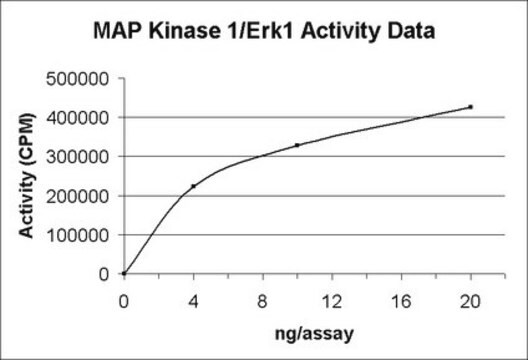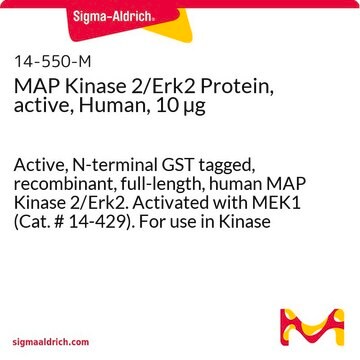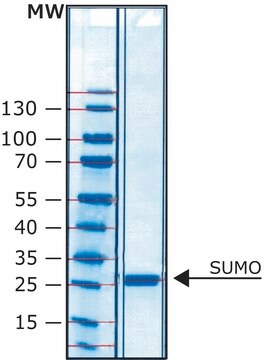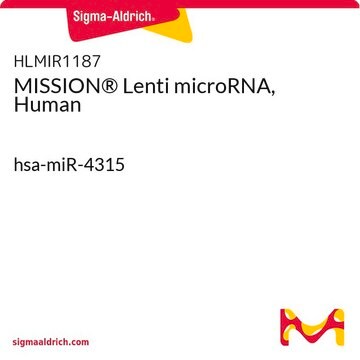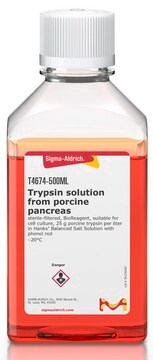E7407
ERK1, active, untagged human
PRECISIO® Kinase, recombinant, expressed in baculovirus infected Sf9 cells, ≥70% (SDS-PAGE), buffered aqueous glycerol solution
Sinonimo/i:
MAPK3, P44ERK1, P44MAPK, PRKM3
Autenticatiper visualizzare i prezzi riservati alla tua organizzazione & contrattuali
About This Item
Prodotti consigliati
Ricombinante
expressed in baculovirus infected Sf9 cells
Livello qualitativo
Nome Commerciale
PRECISIO® Kinase
Saggio
≥70% (SDS-PAGE)
Stato
buffered aqueous glycerol solution
Attività specifica
329-445 nmol/min·mg
PM
~44 kDa
N° accesso UniProt
Condizioni di spedizione
dry ice
Temperatura di conservazione
−70°C
Informazioni sul gene
human ... MAPK3(5595)
Descrizione generale
Extracellular signal-regulated kinase 1 (ERK1) belongs to mitogen-activated protein kinases (MAPK)/ERK family of intermediate proteins in the signaling pathways. This gene contains nine exons and eight introns, and spans 9kb. It is a constitutively expressed protein, the activity of which is altered by the phosphorylation state. It has a higher expression level in nervous tissues. It contains 11 kinase subdomains, common between humans and mice. It has a molecular weight of 44kDa.
Azioni biochim/fisiol
ERK1 (MAPK3) participates in cellular signaling cascades that are activated in response to numerous growth factors and cytokines. Disruption of MAP kinase signaling functionality is associated with disease states including inflammation, cancer and neurodegenerative disease.
Extracellular signal-regulated kinase 1 (ERK1) act as intermediate in multiple signaling cascades, and is acted upon by MEK protein. MEK are essential for Golgi fragmentation during mitosis, and this is achieved by its action upon an alternatively spliced isoform of ERK1, called ERK1c. ERK1/2 signaling plays a key role in cellular response to topoisomerase II poisoning, by activating G2/M checkpoint, and thus, prevents poison-induced cell death. In melanocytes, pleiotrophin suppresses pigmentation or melanogenesis, by degradation of MITF, through the activation of ERK1/2 signaling.
Stato fisico
Supplied in 25 mM MOPS, pH 7.5, with 300 mM NaCl, 0.25 mM DTT, 0.1 mM EDTA, 0.1 mM PMSF, and 25% glycerol
Note legali
PRECISIO is a registered trademark of Merck KGaA, Darmstadt, Germany
Codice della classe di stoccaggio
10 - Combustible liquids
Classe di pericolosità dell'acqua (WGK)
WGK 1
Punto d’infiammabilità (°F)
Not applicable
Punto d’infiammabilità (°C)
Not applicable
Dispositivi di protezione individuale
Eyeshields, Gloves, multi-purpose combination respirator cartridge (US)
Scegli una delle versioni più recenti:
Possiedi già questo prodotto?
I documenti relativi ai prodotti acquistati recentemente sono disponibili nell’Archivio dei documenti.
Yoav D Shaul et al.
The Journal of cell biology, 172(6), 885-897 (2006-03-15)
Extracellular signal-regulated kinase 1c (ERK1c) is an alternatively spliced form of ERK1 that is regulated differently than other ERK isoforms. We studied the Golgi functions of ERK1c and found that it plays a role in MEK-induced mitotic Golgi fragmentation. Thus
Daniel M Aebersold et al.
Molecular and cellular biology, 24(22), 10000-10015 (2004-10-29)
Extracellular signal-regulated kinases (ERKs) are signaling molecules that regulate many cellular processes. We have previously identified an alternatively spliced 46-kDa form of ERK1 that is expressed in rats and mice and named ERK1b. Here we report that the same splicing
F García et al.
Genomics, 50(1), 69-78 (1998-06-20)
The complete genomic structure of the human p44(mapk) gene (HMGW-approved symbol PRKM3) has been determined. The gene covers 9 kb and is composed of nine exons and eight introns. This structure is identical to the previously reported mouse p44(mapk) gene
Ryan H Kolb et al.
PloS one, 7(11), e50281-e50281 (2012-11-21)
Topo II poisons, which target topoisomerase II (topo II) to generate enzyme mediated DNA damage, have been commonly used for anti-cancer treatment. While clinical evidence demonstrate a capability of topo II poisons in inducing apoptosis in cancer cells, accumulating evidence
T G Boulton et al.
Biochemistry, 30(1), 278-286 (1991-01-08)
In rat 1 fibroblasts, insulin has little or no stimulatory effect on the activities of either MAP2 protein kinase or ribosomal protein S6 kinase. In contrast, in rat 1 cells that overexpress the normal human insulin receptor (rat 1 HIRc
Articoli
Alzheimer's Disease
Lipid Induced Insulin Resistance
Il team dei nostri ricercatori vanta grande esperienza in tutte le aree della ricerca quali Life Science, scienza dei materiali, sintesi chimica, cromatografia, discipline analitiche, ecc..
Contatta l'Assistenza Tecnica.